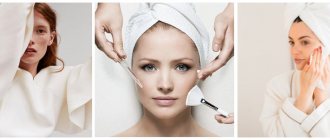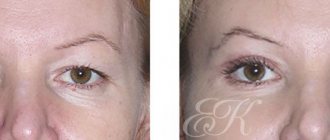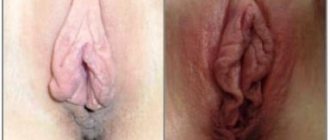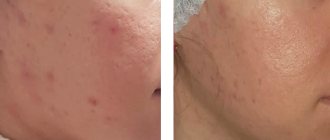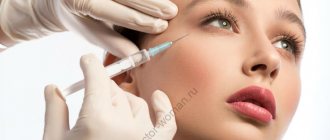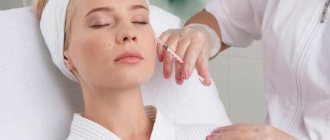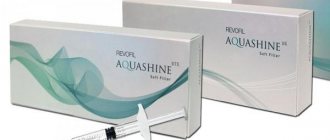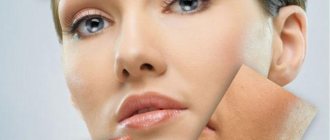With age, the rate of renewal of the epidermis decreases, due to which keratinized cells accumulate in the upper layers of the skin, which prevent oxygen saturation of the skin. The diamond peeling procedure helps to get rid of this layer of cells most effectively and completely painlessly. Diamond peeling (or microdermabrasion) is a unique hardware procedure that combines micropolishing of the skin using diamond crystals. Cleaning occurs using nozzles made of medical steel, which have a special micro-cut with highly abrasive properties. Microcrystals gently mechanically polish the skin, removing 80% of the entire stratum corneum from the skin in one session. During the diamond microdermabrasion procedure, mechanical delicate removal of keratinized epithelium and simultaneous stimulation and renewal of the deep layers of the epidermis and dermis occur.
- No rehabilitation
- Course: 4 – 6 procedures with an interval of 2 weeks
- Visible effect after the first procedure
- Procedure time: 40 min
- Cost 2500 rub.
Result
- Cleansing the skin of dead cells
- Removing blackheads
- Launching the cell regeneration process, accelerating the production of collagen, hyaluronic acid and elastin
- Getting rid of age spots and freckles
- Leveling skin texture, smoothing scars
- Improved complexion
- Smoothing out fine wrinkles
- Improving overall tone, increasing elasticity and lifting by stimulating collagen production
We at LRCLINIC value our reputation; our cosmetologists use the Israeli-made multifunctional device “FORMA-TK”
, allowing you to solve a whole range of aesthetic problems effectively and safely.
Differences between chemical and laser peels
Both methods have advantages and disadvantages, indications, contraindications, and side effects. Based on these and other criteria, we will review these face resurfacing technologies.
Indications and results
Both procedures stimulate regenerative processes in the skin tissue, refresh the complexion, and get rid of wrinkles. Laser is often used to achieve a lifting effect. Acids give good results in the fight against oily skin and age spots.
The effect of laser peeling is more noticeable and lasts for a long time. The recovery process occurs naturally.
…
Contraindications
Laser resurfacing and acid peeling have the same list of contraindications:
- pregnancy and breastfeeding;
- oncological diseases;
- herpes;
- skin diseases, ulcers;
- tendency to scars;
- weak immunity, fever;
- recently tanned.
During the consultation, the cosmetologist conducts a survey. You should not hide the presence of contraindications - this can lead to serious consequences in the case of both anti-aging technologies.
…
Safety
Despite the fact that during laser resurfacing, particles of the top layer of skin are removed, the procedure is safer than acid peeling. During the session, an unexpected reaction to the components of the composition may occur. There is also a risk of overexposing the composition to the skin.
…
Preparation
Skin preparation is required for 2 weeks before the acid peeling session. It includes avoiding the use of products containing acids, going to swimming pools and baths, facial hair removal, and treating acne. An allergy test is recommended.
Before laser resurfacing, such lengthy preparation is not required; you just need to avoid sunbathing.
…
Scope
The chemical exfoliation composition is applied to the entire face. It is extremely difficult to focus on a single shortcoming with its help.
The laser device acts on the skin in a targeted manner, so it is much easier to concentrate efforts on problem areas and skin defects.
…
Side effects and recovery
After a chemical peel, noticeable redness appears on the face, close to a burn. The recovery process continues for more than 2 weeks. By the end of the first week, a large crust forms on the surface of the skin. Over time it goes away.
Laser peeling specifically removes dead skin areas and blemishes. The patient will be able to fully recover in 10 days if he follows the specialist’s recommendations. After laser treatment, crusts also appear on the skin, but they are small and quickly go away.
…
Price
The main disadvantage of laser peeling is the high cost of sessions.
Acid peeling compounds are much cheaper, so anyone can undergo the course of procedures in the absence of contraindications.
…
Combination with other techniques
Laser resurfacing is combined with almost any additional anti-aging techniques - injections, superficial procedures and plastic surgeries. The laser does not affect the results of other sessions - the final result only gets better.
Acid peeling is contraindicated in the presence of previously performed other hardware and injection procedures in the area of intervention.
Advantages
- Availability. At LRCLINIC the price for diamond microdermabrasion is one of the lowest in Kazan
- Painless. Diamond facial peeling does not cause discomfort during the procedure
- Versatility. Can be used for skin of any type and phototype. Our cosmetologists will select options for diamond peeling individually, taking into account the condition of the skin.
- Safety. We work on modern medical equipment of the latest generation with a Registration Certificate from the Ministry of Health of the Russian Federation
- Does not cause allergic reactions
- Does not require rehabilitation
- Not only cleanses
, but also stimulates the skin regeneration process, slowing down aging
Effects of vacuum cleaning
The result of vacuum peeling is not limited to clean skin , although the essence of the procedure is deep cleaning - removing particles of fat and dirt accumulated in the pores, as well as eliminating the so-called acne cores.
Along with the main effect, vacuum peeling allows you to achieve:
- improving blood supply to the skin (accelerating metabolic processes, regeneration);
- launching or activating the natural mechanism for removing toxins (lymphatic effect of vacuum technology);
- renewal of the outer layer;
- Unlike many related peeling techniques, vacuum cleaning is most effective in terms of a relaxing massage.
Vacuum treatment is carried out using special equipment with a frequency of 1 to 4 times a month. Peeling equipment is a mobile device with a small “handle”. Through the latter, air is pumped onto the prepared base (negative pressure). As a result, the cosmetologist achieves the effect of a vacuum cleaner with different suction intensity.
Procedure
Before the procedure, a consultation is held with a cosmetologist, during which skin characteristics and contraindications are identified. The doctor cleanses the skin, adjusts the FORMA TK device to your skin type and begins the procedure. The procedure is absolutely painless; using a special diamond-coated applicator, the doctor delicately carries out the procedure along massage lines. After the diamond peeling, a soothing product with a high SPF is applied.
Recommendations before and after the diamond peeling procedure:
- One week before the procedure:
- do not perform scrubbing, peeling, injection procedures
- don't sunbathe
- Several days after the procedure:
- Avoid procedures that irritate the skin (cleansing with scrubs, peelings, alcohol-containing products, etc.),
- It is not recommended to carry out intense training, and also not to visit the sauna, bathhouse, solarium, swimming pools,
- When going outside, use sunscreen on exposed skin.
When is it recommended to use the vacuum technique?
Unlike microdermabrasion, which is recommended for women over the age of 45, vacuum peeling is better suited for teenagers and young girls .
Working with vacuum equipment on sagging skin is carried out with the utmost care so as not to achieve the opposite effect (not to stretch the skin, causing new wrinkles). With sufficient qualifications and experience of the master, this is not a problem. But women over 40 should only trust peeling of delicate areas (skin, face, hands) using vacuum technology to competent specialists.
The vacuum peeling procedure is highly recommended:
- people with atonic skin;
- teenagers and adults suffering from persistent acne;
- patients with oily skin, large pores, vitamin deficiency;
- with a decrease in general tone.
Peeling is carried out at the stage of acne maturation. Pink rashes, suppuration, spider veins are prohibitive conditions for peeling with a vacuum apparatus. As well as infections, neurodermatitis, dermatoses. Peeling will be effective at the recession stage to eliminate the consequences.
Contraindications
- Before undergoing the procedure, you must consult your doctor.
- Sensitive skin
- Skin rashes, including pustular rashes
- Violation of the integrity of the skin
- Viral, infectious skin diseases
- Pregnancy, lactation period
- Autoimmune diseases
- Acute infectious diseases
- Chronic diseases in the acute stage
- Diabetes
- Tendency to form keloid scars
- Cuperosis (dilated blood vessels on the face)
Qualified LRClinic specialists will restore youth and beauty to your face.
Microdermabrasion
28.09.2020 | Devices, Cosmetology, Beauty
Diamond microdermabrasion
Diamond microdermabrasion is an advanced method of microcrystalline dermabrasion. Diamond peeling provides a non-surgical skin resurfacing procedure using sterile diamond-cut tips to remove superficial layers of skin, followed by vacuum aspiration of dead skin cells and surface impurities. Microdermabrasion is a gentle method that requires virtually no pain relief. Mechanical removal of the top layer of keratinized epithelium opens the pores of the sebaceous and sweat glands, reflexively stimulates microcirculation, makes the skin smooth, helps remove wrinkles and pigmentation, reduce scarring, stimulates skin regenerative processes.
Regular use of the diamond microdermabrasion method in combination with subsequent cosmetic care (the penetration of the active ingredients of cosmetic preparations into the upper layers of the skin is enhanced) helps nourish the skin, restore cellular activity, promoting healthy skin. The result of this procedure is healthy, glowing skin (improved color, smoother texture).
Microdermabrasion is a modern method of treatment and skin care, which is based on mechanical action using medical steel attachments that have a special micro-cut with highly abrasive properties.
The device uses highly purified diamond microcrystals as an abrasive material. They are completely intact, do not cause any chemical reactions upon contact with the skin and have excellent abrasive ability.
Diamond microdermabrasion set (9 attachments, 2 holders)
Physiological basis of the method
The skin, like no other organ, is exposed to various environmental factors. Therefore, it is a homeostatic system, not only functioning in the interests of the whole organism (barrier-protective and other functions), but also capable of constantly recovering and maintaining its normal state. It is not surprising that the skin has such a highly developed mechanism of restoration and reorganization, which is activated by any damage. Biological reorganization consists of two processes: destruction and regeneration. By influencing the skin with a mechanical factor, the specialist triggers the process of inflammation followed by regeneration. At the same time, microdermabrasion differs from classical dermabrasion in the depth of damage and the degree of injury. With microdermabrasion, the effect is softer and can be easily adjusted in depth (or degree of damage). As a result, the wound process and subsequent inflammation also have a milder course.
The depth of impact is determined by several factors: the strength of the vacuum, the abrasive ability of the nozzle (size of abrasive particles), the number of passes over the same zone, and the technique of impact (dotted, continuous).
Conventionally, in cosmetology practice, it is customary to distinguish three depths of microdermabrasion peeling; the first two options are more often used:
- Superficial – characterized by a superficial effect on keratinizing epidermal particles for the purpose of exfoliating them. This peeling is accompanied by slight redness, which disappears within a few minutes during subsequent cosmetic care (depth of influence - stratum corneum of the epidermis).
- Medium depth peeling. This is a deeper peeling with pronounced hyperemia and sometimes slight swelling after the procedure (the depth of exposure is the granular layer of the epidermis).
- Deep peeling – deep impact with grinding almost to the papillary layer. It is carried out by a doctor while observing all the rules of asepsis and antisepsis. As a rule, it is accompanied by pronounced signs of reactive inflammation: redness, swelling, slight pain and subsequent active peeling (level of exposure - affects the basement membrane of the epidermis).
Indications for microdermabrasion
The essence of the method
Delicate removal of part of the surface layer of the epidermis and simultaneous stimulation and renewal of its deep layers, as well as the dermis. • Reduces age spots (hyperpigmentation) and fine wrinkles. • Opens pores, thereby making them less noticeable. • Stimulates collagen production. • Improves overall skin tone and texture. • Returns skin elasticity and smoothes it.
Indications for use: • correction of signs of photo- and chronoaging (stimulation of the process of collagen production, improvement of skin structure and its rejuvenation, reduction of the depth and number of wrinkles); • reduction of scar changes (including post-acne), stretch marks; • elimination of age spots; • alignment of facial tone; • improvement of the condition of dull, lifeless skin, roughened by exposure to sunlight; • micro-resurfacing is an ideal solution for women and men with problematic and oily skin, acne-prone skin, enlarged pores, and small scars.
Contraindications to diamond microdermabrasion
- Acute inflammatory processes (including pustular skin lesions)
- Chronic dermatoses in the acute stage
- Viral infections (herpes, etc.)
- Malignant neoplasms; benign formations with negative development dynamics
- Genetic skin diseases
- Multiple nevi
- Multiple telangiectasias
- Tendency to form or have keloid scars
- Skin prone to irritation
- Epilepsy
- Severe systemic diseases (NC /shortness of breath, peripheral edema/, hypertension stages II - IV, coronary artery disease with symptoms of angina pectoris and arrhythmia FC III - IV, severe atherosclerosis, etc.).
This method has a number of advantages: • Stimulates the process of skin regeneration, slowing down aging. • Guarantees maximum hygiene and sterility. • Painless. • Does not require the use of chemicals.
Diamond peeling procedure protocol
Recommended frequency of procedures
| Procedure | Interval between procedures (days) | Number of procedures per course |
| Facial peeling | 6-10 | 3-5 |
| Fine wrinkles | 7-13 | 6-8 |
| Neck area rejuvenation | 12-14 | 3-5 |
| Post-acne scars | 7-12 | 8-10 |
| Hyperpigmentation | 7-12 | 8-10 |
- Use special attachments coated with diamond edges of varying degrees of abrasiveness for contact with the skin. Use smooth sliding movements to treat the affected area. Do not hold the nozzle in one place for too long to avoid damaging the skin.
- Gradually increase the vacuum power from minimum to maximum, it is recommended to work at medium settings, do not use maximum power unless necessary.
- Gently stretch the skin between your thumb and forefinger and move the nozzle 2-3 times over the affected area. To better work out the treatment area and avoid the appearance of red stripes, it is recommended to move the nozzle several times perpendicular to the previous direction of treatment. The directions of influence and technique may be different depending on the tasks assigned (when working with linear skin defects (scars, stretch marks, wrinkles), movements of the nozzle should be carried out perpendicular to the defect).
- After the procedure, tonize the skin, dry it, then carry out cosmetic care according to your skin type (depending on the problem).
- To clean the attachments, use an ultrasonic cleaner, a toothbrush or a cotton pad moistened with medical alcohol to remove dirt, then use a disinfectant solution (soak the attachments for 30 minutes) followed by UV sterilization or use temperature treatment methods (dry heat).
The movement pattern of the tip during microdermabrasion:
Purpose of nozzles:
A larger number of nozzles corresponds to a smaller size of abrasives (nozzles with a larger number have a more gentle effect on the skin).
| Nozzles: | Purpose: |
| Recommended for use on the body, as well as for the correction of deep defects on the face (hyperkeratosis /including perifollicular/, pigment spots, scars, stretch marks, oily skin with post-acne manifestations): medium, deep effect up to the papillary dermis. | |
| Recommended for use on the face and body - they remove layers of the epidermis down to the basement membrane ( medium and deep effects). Work with medium-deep skin defects (pigment spots, scars, stretch marks, wrinkles). Correction of signs of photoaging and oily skin. | |
| Recommended for normal and sensitive age skin, including those with rosacea, facial skin. Superficial and superficial-medial impact. | |
| D160: Recommended for treating areas of hyperkeratosis, nasal area, perioral wrinkles. Superficial, middle impact. D180: Recommended for the area around the eyes, correction of crow's feet. Superficial impact. With the transverse technique - a median, deep impact . | |
| Recommended for lymphatic drainage massage of the face, neck, and décolleté. |
additional information
Surgical scars
The most significant indicator for determining the number of procedures is the width of the scar. Its length only affects the duration of the session, since the scar is treated completely. During the regeneration process, new skin cells form like a bridge between the unaffected edge of the skin and the scar. The number of procedures depends on the regenerative ability of the skin, the intensity and depth of the effect, as well as on skin care at home.
Acne scars
Acne often leaves deep scarring on the skin. During the treatment, the face is treated completely, and scars are treated additionally. After dermabrasion, we usually recommend that patients undergo a course of ultrasonic peeling or chemical peeling to normalize the production of skin secretions.
Stretch marks (striae)
It is necessary to distinguish between real, wide stretch marks that appeared during pregnancy, and small stretch marks that were the result of rapid changes in weight or genetically determined connective tissue deficiency. The width of the former can reach 10mm or more, then they should be treated like surgical scars of similar width. For narrow stretch marks 1-2mm wide, there is a special technique. The selected area is treated in the prescribed manner until the skin turns red.
Hyperpigmentation
The appearance of age spots can be caused by a number of factors: pregnancy, taking oral contraceptives, using strong perfumes when tanning. They are all removed fairly quickly. For patients taking birth control pills, dermabrasion should be performed regularly throughout the year, since the appearance of age spots in this case is due to a deficiency of the stratum lucidum of the epidermis.
Do not use diamond microdermabrasion on the following areas:
- Sensitive skin.
- Skin rashes, incl. pustular.
- Violations of the integrity of the skin.
- Postoperative scar for up to 12 months.
- Edema.
- Do not point the nozzles at the area of the eyeballs, genitals, or heart.
- Nevi, hemangiomas, benign and malignant skin tumors, liver spots.
- Viral skin diseases (herpes, etc.).
General recommendations for performing procedures
• always start treatment carefully, observing the skin reaction; a vacuum of too much power can lead to damage to the vascular wall with subsequent inflammation; • swelling and hyperemia may occur as a result of the procedures, but disappear within a few hours; • overly aggressive technique can lead to fine-plate peeling over the next 3-4 days; • if the epidermis is excessively damaged, bleeding from the superficial layers of the dermis is possible; • Diamond microdermabrasion cannot be used on sensitive areas such as the movable part of the eyelids.
Procedure protocol for pigmentation, wrinkles, stretch marks, cellulite, etc.
- Cleansing the skin with phytomus.
- Skin cleansing with enzyme or weak acid peeling.
- Thoroughly clean and dry the skin.
- Perform a superficial or medium microdermabrasion peeling procedure.
- Administration of a substance according to the problem (phonophoresis, electroporation).
- Applying a mask with a calming effect: Optima mask, alginate, hydrogel, fabric.
- Applying a soothing serum.
- Applying cream with SPF 50.
Procedure protocol for scar removal
- Cleansing the skin with phytomus.
- Skin cleansing with enzyme or weak acid peeling.
- Cold hydrogenation for 10-15 minutes if the skin is very hyperkeratotic.
- Thoroughly clean and dry the skin.
- Carry out a deep microdermabrasion peeling procedure.
- Applying a mask with a calming effect: Optima mask, alginate, hydrogel, fabric.
- Applying a soothing serum or skin problem serum.
- Applying cream with SPF 50.
Cosmetic processor 2 in 1 apch-01 (with vacuum jars)
BUY A DEVICE
Share
Leave feedback
Click to cancel reply.
Diamond peeling specialists
Fasakhova Elvira Idrisovna
Chokheli Irina Stefanovna
Syrtlanova Maria Vadimovna
Rafikova Rezeda Fartovna
TOP procedures in our clinic
- Biorevitalization with hyaluronic acid
- Plasmolifting of the face
- Wrinkle correction
- Facial mesotherapy
- Collagen rejuvenation
Non-ablative lasers (eg, diode, non-ablative erbium, Fraxel) are less harsh on the skin and heat the skin so that the amount of damage is minimal. Keep in mind that since non-ablative lasers are not as powerful as ablative lasers, multiple sessions may be required to achieve the best results.
While chemical peels and laser resurfacing have many differences, there are also similarities in the benefits they offer and the problems they can solve. For example, a strong TCA (trichloroacetic acid) chemical peel can provide results similar to laser resurfacing. In some cases, both peels and laser can be used to treat acne and acne scars.
The two treatments also differ depending on skin tone. People with darker skin tones benefit most from chemical peels, as peels are an effective treatment for hyperpigmentation. Dark skin tones are often prone to hyperpigmentation problems such as post-inflammation hyperpigmentation (PIH), which occurs due to increased amounts of melanin in their skin. Chemical peels use acidic solutions to stimulate collagen production and contain antioxidants that are better able to penetrate darker skin and treat pigmentation.
Why do pimples* appear on the forehead?
Have pimples* on your forehead and you don’t know what to do? First, find out the reason. Teenage acne is common. It's all due to hormonal changes.
But rashes can also appear at an older age. What causes pimples* on the forehead? First of all, this is due to internal problems that need to be found and eliminated. In addition to hormonal imbalance, the condition can be affected by problems with the gastrointestinal tract, deficiency of nutrients - vitamins A and D, zinc, omega-3 fatty acids, iron, as well as improper care50.4. Another answer to the question of why acne suddenly appeared* is stress50.
Often, consultation with several specialists is necessary - a dermatologist, endocrinologist, gynecologist, gastroenterologist. Although there are a huge number of ways to get rid of this phenomenon - from the use of topical and systemic medications to cosmetic procedures. A comprehensive approach is required, and microdermabrasion can also significantly improve the appearance of the skin.
It can be useful in the fight against acne* because once the sebaceous glands and pores are cleansed, the penetration of medications used to treat acne will improve. However, the decision about therapy and expected effectiveness must be made by a dermatologist.
During the diamond peel itself, the outer layers of the epidermis are peeled off, which allows you to refresh the surface of the skin and stimulate its regeneration. In addition, microdermabrasion helps tighten pores.
How often can you do a facial peel?
The frequency of the procedure depends on the skin type and the method used. When contacting a cosmetologist, the specialist will prescribe the correct course and the appropriate number of procedures. For independent mechanical cleansing with gentle scrubs, you can adhere to the following frequency:
- For dry skin, courses are suitable for 6 procedures - once every 14 days.
- For combined – weekly for one month.
- For normal – after 4 days for 1.5 months.
- For oily people – 2 times a week for one month.
How to treat acne* on the forehead?
The first thing you need to do is get examined by a dermatologist. The doctor will recommend treatment. For mild to moderate acne, this may include the use of topical antibiotics, for example, Clindovit® gel 6.18. This is a drug based on clindamycin phosphate, which upon contact with the skin hydrolyzes to form clindamycin6.
Clindovit® gel is recommended to be combined with azelaic acid (for example, Azelik® gel) or benzoyl peroxide in order to reduce antibiotic resistance28.
*acne
